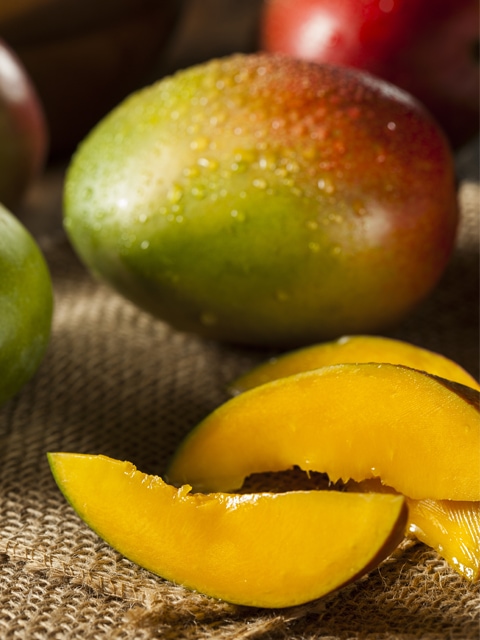


 Add to favorites
Add to favorites
 The first time I had a mango I had juice dripping down my arms. As I was taking in each juicy bite, I had no idea about the immense health benefits that I was taking in.
The first time I had a mango I had juice dripping down my arms. As I was taking in each juicy bite, I had no idea about the immense health benefits that I was taking in.
As my eyes were rolling back in head, as my tummy was doing a happy dance… my body was receiving an abundance of fiber, vitamin B6, vitamin A and vitamin C. In the mineral department, my body was taking in potassium, magnesium, and copper.
And let’s not forget quercetin, beta-carotene, and astragalin. These powerful antioxidants have the power to neutralize free radicals throughout the body.
The peak season for mangoes runs from May through September, but if you live in warm climates year-round, you might find them readily available in the stores.
Fresh mangoes can be enjoyed in so many ways. As is, blended into puddings, added to smoothies, diced and tossed into a salad, or blended into sauces and dressings.
Use caution when peeling a mango… they are slippery and I don’t want you to cut yourself.
If you find yourself with far too many mangoes and can’t eat them up before going bad, you can freeze them. To freeze, remove the skin, dice and place individual chunks or slices on a flat tray. Slide the tray into the freezer until firm. Once firm, remove and place the mango pieces into freezer safe zip-lock bags. I like to use food saver bags but that requires a special machine. They are worth the investment. They should stay fresh for 8 to 12 months properly sealed.
Another great option is to dehydrated mangoes. They are great for snacking, hiking trips, airplane rides, munch on them as you motor down the road, or packed in school lunch pails. You can learn how to dehydrate mangoes (here). You can rehydrate them to use as thickeners in a recipe. Or just puree them, pour on a non-stick dehydrator sheet and create wraps or cones out of them. As with all dehydrated foods, please be sure to drink extra water since dried foods can be drying on the digestive system. Also be aware, that the natural sugars in dehydrated fruits become very concentrated and it is easy to over-consume them.
There are many varieties of mangoes that do not turn red, orange or yellow, so never really go by the coloring. T0 test for ripeness, press down lightly on the flesh of the mango with your fingertip. You should see a slight depression on the surface. They should also be fragrant, plump and heavy for its size.
If you buy them unripe, keep the mangoes in a paper bag in a warm place. They will ripen within a few days. If you keep the unripe mangoes at room temperature, it may take them up to 1 week to fully ripen.
If you have a latex allergy, a reaction is possible with mangos, particularly green mangos. This reaction develops because of anacardic acid. Mango peel and sap contain urushiol, the chemical in poison ivy and poison sumac which can cause an allergic reaction in susceptible individuals. Mangos are ripened by some dealers using calcium carbide, which can cause serious health problems (one more reason to buy organic). If you do have inorganic mangos, wash them properly before consuming or soak overnight in water. Source